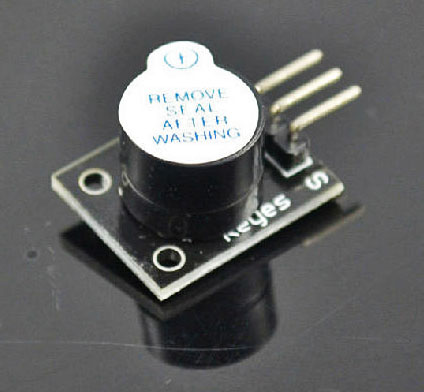Brick-Noisemakers
Jump to navigation
Jump to search
Passive Beeper Brick:
Brick-Noisemakers
Active Buzzer Brick:
This brick has a "Buzzer" module that makes sound when activated by applying 5 volts (usually from an Arduino Output pin). It is NOT a "piezo" element which has to be switched on and off rapidly to make sound.
These Electronic Bricks are very easily connected to Arduino using 3-wire cables plugged into a YourDuino RoboRED. These come with the YourDuino Electronic Brick Set.
To quickly test these devices, run the Good Old Blink Program (File>Examples>Basic>Blink) , and plug them into Arduino I/O #13. They should beep On and Off.
Passive Beeper Brick:
This brick has a small "piezo" element that is like a tiny speaker. It looks almost like the Buzzer Brick. It does not make noise unless a changing On-OFF signal is sent to it. Arduino includes a Tone library that can be used to make many different sounds on the Beeper Brick.
Plug the Electronic Brick on a 3-pin cable and connect to RoboRED Pin 11
Beep / sweepUp / sweepDown Examples:
This shows/plays examples of making different sounds with the Arduino Tone library.
(Copy the text in the box below and Paste it into a blank Arduino IDE window)
(Runs once and stops. Push RESET button to replay.) LISTEN CLOSELY to the Beeper brick!
/* YourDuino Electronic Brick Set Example: Tone Beeper Sounds - Uses the Arduino Tone Library to make sounds on the Beeper in the set, or an 8 Ohm speaker. - SEE the comments after "//" on each line below - CONNECTIONS: - Beeper/Speaker on Arduino port 11 (Can be changed) - If speaker is used, Use 100 ohm resistor (or two 220 ohms in parallel) in series with speaker. - V1.03 03/26/15 Questions: terry@yourduino.com */ /*-----( Import needed libraries )-----*/ //None /*-----( Declare Constants and Pin Numbers )-----*/ #define TONE_PIN 11 // Which pin to connect to // See: http://arduino.cc/en/tutorial/tone #define TONE_LOWEST 800 #define TONE_HIGHEST 2100 #define TONE_FREQUENCY_STEP 5 #define TONE_STEP_DELAY 2 /*-----( Declare objects )-----*/ //none /*-----( Declare Variables )-----*/ int toneFrequencyNow; void setup() /****** SETUP: RUNS ONCE ******/ { beep(500); delay(2000); sweepUp(); delay(2000); sweepDown(); }//--(end setup )--- void loop() /****** LOOP: RUNS CONSTANTLY ******/ { // Nothing in Loop }//--(end main loop )--- /*-----( Declare User-written Functions )-----*/ // none void beep(int howLong) { tone(TONE_PIN, 2100); delay(howLong); noTone(TONE_PIN); }//END beep //-------------------------------------------------------------- void sweepUp() { for (toneFrequencyNow = TONE_LOWEST; toneFrequencyNow < TONE_HIGHEST; toneFrequencyNow += TONE_FREQUENCY_STEP) { tone(TONE_PIN, toneFrequencyNow); delay(TONE_STEP_DELAY); } noTone(TONE_PIN); }// END sweepUp //-------------------------------------------------------------- void sweepDown() { for (toneFrequencyNow = TONE_HIGHEST; toneFrequencyNow > TONE_LOWEST; toneFrequencyNow -= TONE_FREQUENCY_STEP) { tone(TONE_PIN, toneFrequencyNow); delay(TONE_STEP_DELAY); } noTone(TONE_PIN); } // sweepDown //*********( THE END )***********
Tune Playing Example:
(Copy the text in the box below and Paste it into a blank Arduino IDE window)
(Runs once and stops. Push RESET button to replay.) LISTEN CLOSELY to the Beeper brick!
/* YourDuino Electronic Brick Set Example: Tone Beeper test - Uses the Arduino Tone Library to make sounds on the Beeper in the set, or an 8 Ohm speaker. - SEE the comments after "//" on each line below - CONNECTIONS: - Beeper/Speaker on Arduino port 11 (Can be changed) - If speaker is used, Use 100 ohm resistor (or two 220 ohms in parallel) in series with speaker. - V1.03 03/26/15 Questions: terry@yourduino.com */ /*-----( Import needed libraries )-----*/ //None /*-----( Declare Constants and Pin Numbers )-----*/ #define TonePIN 11 // Which pin to connect to // See: http://arduino.cc/en/tutorial/tone #define NOTE_A3 220 #define NOTE_B3 247 #define NOTE_G3 196 #define NOTE_C4 262 /*-----( Declare objects )-----*/ //none /*-----( Declare Variables )-----*/ int thisNote; // which note to play now int noteDuration; // How long to play the note int pauseBetweenNotes; // Length between notes // notes in the melody: (0 is a 'rest' ) // This is an "array" of data holding the melody int melody[] = { NOTE_C4, NOTE_G3,NOTE_G3, NOTE_A3, NOTE_G3,0, NOTE_B3, NOTE_C4}; // note durations: 4 = quarter note, 8 = eighth note, etc.: int noteDurations[] = { 4, 8, 8, 4,4,4,4,4 }; void setup() /****** SETUP: RUNS ONCE ******/ { // go through each of the notes of the melody: for (thisNote = 0; thisNote < 8; thisNote++) { // Calculate and play one note and a pause after it // to calculate the note duration, take one second // divided by the note type. // e.g. quarter note = 1000 / 4, eighth note = 1000/8, etc. noteDuration = 1000/noteDurations[thisNote]; tone(TonePIN, melody[thisNote],noteDuration); // to distinguish the notes, set a minimum time between them. // the note's duration + 30% seems to work well: pauseBetweenNotes = noteDuration * 1.30; delay(pauseBetweenNotes); } // End of one note }//--(end setup )--- void loop() /****** LOOP: RUNS CONSTANTLY ******/ { // Nothing. Once was enough :-) }//--(end main loop )--- /*-----( Declare User-written Functions )-----*/ // none //*********( THE END )***********
